Draw a Circle With Centre O and Radius 2.5cm
Selina Concise Mathematics Class 10 ICSE Solutions Constructions (Circles)
Selina Publishers Concise Mathematics Grade x ICSE Solutions Chapter 19 Constructions (Circles)
Constructions Circles Do 19 – Selina Concise Mathematics Class 10 ICSE Solutions
Question 1.
Depict a circle of radius iii cm. Mark a point P at a distance of 5 cm from the middle of the circle drawn. Draw 2 tangents PA and PB to the given circle and measure the length of each tangent.
Solution:
Steps of Construction:
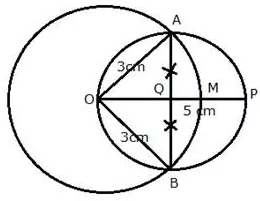
- Draw a circle with eye O and radius iii cm.
- From O, have a point P such that OP = 5 cm
- Draw a bisector of OP which intersects OP at M.
- With centre M, and radius OM, depict a circle which intersects the given circumvolve at A and B.
- Join AP and BP.
AP and BP are the required tangents.
On measuring AP = BP = 4 cm
Question two.
Draw a circle of diameter of 9 cm. Mark a point at a altitude of 7.5 cm from the centre of the circle. Draw tangents to the given circle from this exterior signal. Measure the length of each tangent.
Solution:
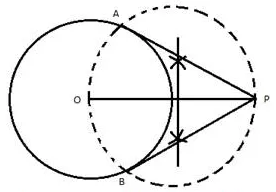
- Describe a circle of diameter 9 cm, taking O every bit the eye.
- Mark a indicate P outside the circumvolve, such that PO = 7.5 cm.
- Taking OP as the bore, draw a circle such that it cuts the earlier circle at A and B.
- Join PA and Atomic number 82.
Thus, PA and Lead are required tangents. PA = Pb = half-dozen cm
Question 3.
Draw a circumvolve of radius 5 cm. Draw two tangents to this circle then that the angle between the tangents is 45º.
Solution:
Steps of Structure:
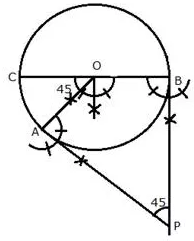
- Draw a circle with centre O and radius BC = 5 cm
- Draw arcs making an angle of 180º- 45º = 135º at O such that ∠AOB = 135º
- AT A and B, describe two rays making an angle of 90º at each indicate which meet each other at indicate P, outside the circle.
- AP and BP are the required tangents which brand an angle of 45º with each other at P.
Question 4.
Draw a circumvolve of radius four.5 cm. Draw two tangents to this circumvolve so that the angle betwixt the tangents is 60º.
Solution:
Steps of Construction:
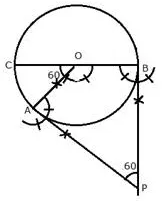
- Draw a circle with middle O and radius BC = 4.5 cm
- Draw arcs making an angle of 180º – 60º = 120º at O such that ∠AOB = 120º
- AT A and B, describe two rays making an bending of 90º at each point which run into each other at bespeak P, exterior the circle.
- AP and BP are the required tangents which make an angle of 60º with each other at P.
Question five.
Using ruler and compasses only, describe an equilateral triangle of side 4.5 cm and depict its circumscribed circle. Measure out the radius of the circle.
Solution:
Steps of construction:
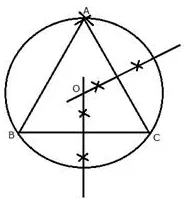
- Draw a line segment BC = 4.5 cm
- With centers B and C, draw 2 arcs of radius 4.five cm which intersect each other at A.
- Join Air conditioning and AB.
- Draw perpendicular bisectors of Air-conditioning and BC intersecting each other at O.
- With eye O, and radius OA or OB or OC describe a circumvolve which volition pass through A, B and C.
This is the required circumcircle of triangle ABC.
On measuring the radius OA = 2.6 cm
Question 6.
Using ruler and compasses but.
(i) Construct triangle ABC, having given BC = 7 cm, AB – AC = ane cm and ∠ABC = 45°.
(2) Inscribe a circle in the ∆ABC constructed in (i) above. Mensurate its radius.
Solution:
Steps of Construction:
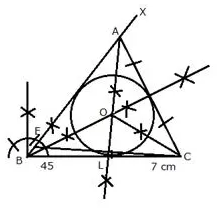
i) Construction of triangle:
- Draw a line segment BC = vii cm
- At B, draw a ray BX making an angle of 45º and cut off BE = AB – AC = 1 cm
- Bring together EC and draw the perpendicular bisector of EC intersecting BX at A.
- Join Ac.
∆ABC is the required triangle.
ii) Construction of incircle:
- Depict bending bisectors of ∠ABC and ∠ACB intersecting each other at O.
- From O, draw perpendiculars OL to BC.
- O as eye and OL as radius draw circle which touches the sides of the ∆ABC. This is the required in-circle of ∆ABC.
On measuring, radius OL = i.8 cm
Question seven.
Using ruler and compasses merely, draw an equilateral triangle of side 5 cm. Depict its inscribed circle. Measure the radius of the circle.
Solution:
Steps of Construction:
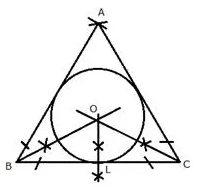
- Draw a line segment BC = 5 cm
- With centers B and C, draw two arcs of 5 cm radius each which intersect each other at A.
- Join AB and AC.
- Draw angle bisectors of ∠B and ∠C intersecting each other at O.
- From O, draw OL ⊥ BC.
- At present with heart O and radius OL, draw a circle which will bear upon the sides of ∆ABC
On measuring, OL = 1.4 cm
Question 8.
Using ruler and compasses only,
(i) Construct a triangle ABC with the following data:
Base AB = 6 cm, BC = 6.2 cm and ∠CAB – 60°
(2) In the same diagram, draw a circumvolve which passes through the points A, B and C and mark its centre every bit O.
(3) Draw a perpendicular from O to AB which meets AB in D.
(iv) Bear witness that AD = BD
Solution:
Steps of Construction:
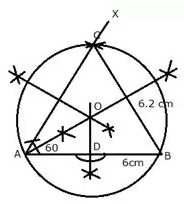
- Describe a line segment AB = 6 cm
- At A, draw a ray making an bending of 60º with BC.
- With B every bit center and radius = 6.2 cm describe an arc which intersects AX ray at C.
- Bring together BC.
∆ABC is the required triangle. - Draw the perpendicular bisectors of AB and AC intersecting each other at O.
- With centre O, and radius as OA or OB or OC, draw a circle which will pass through A, B and C.
- From O, draw OD ⊥ AB.
Proof: In right ∆OAD and ∆OBD
OA = OB (radii of same circle)
Side OD = OD (common)
∴ ∆OAD ≅ ∆OBD (RHS)
⇒ AD = BD (CPCT)
Question 9.
Using ruler and compasses only construct a triangle ABC in which BC = iv cm, ∠ACB = 45° and perpendicular from A on BC is 2.5 cm. Draw a circumvolve circumscribing the triangle ABC.
Solution:
Steps of Structure:
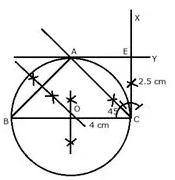
- Describe a line segment BC = 4 cm.
- At C, draw a perpendicular line CX and from it, cut off CE = ii.v cm.
- From E, draw another perpendicular line EY.
- From C, draw a ray making an angle of 45º with CB, which intersects EY at A.
- Join AB.
∆ABC is the required triangle. - Depict perpendicular bisectors of sides AB and BC intersecting each other at O.
- With middle O, and radius OB, describe a circle which volition laissez passer through A, B and C.
Measuring the radius OB = OC = OA = two cm
Question x.
Perpendicular bisectors of the sides AB and Ac of a triangle ABC meet at O.
(i) What do you call the point O?
(two) What is the relation betwixt the distances OA, OB and OC?
(three) Does the perpendicular bisector of BC laissez passer through O?
Solution:
Steps of Construction:
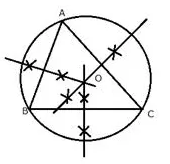
- O is called the circumcentre of circumcircle of ∆ABC.
- OA, OB and OC are the radii of the circumcircle.
- Yes, the perpendicular bisector of BC volition pass through O.
Question 11.
The bisectors of angles A and B of a scalene triangle ABC meet at O.
i) What is the signal O called?
ii) OR and OQ are drawn perpendiculars to AB and CA respectively. What is the relation betwixt OR and OQ?
iii) What is the relation between angle ACO and angle BCO?
Solution:
Steps of Construction:
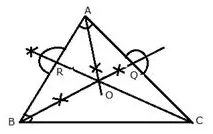
- O is called the incentre of the incircle of ∆ABC.
- OR and OQ are the radii of the incircle and OR = OQ.
- OC is the bisector of bending C
∴ ∠ACO = ∠BCO
Question 12.
i) Using ruler and compasses just, construct a triangle ABC in which AB = eight cm, BC = 6 cm and CA = 5 cm.
ii) Find its incentre and mark it I.
three) With I as centre, draw a circle which will cut off 2 cm chords from each side of the triangle.
Solution:
Steps of Construction:
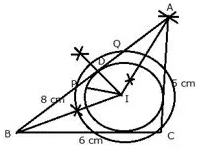
- Draw a line segment BC = 6 cm.
- With centre B and radius 8 cm depict an arc.
- With centre C and radius 5 cm draw some other arc which intersects the first arc at A.
- Join AB and AC.
∆ABC is the required triangle. - Draw the bending bisectors of ∠B and ∠A intersecting each other at I. Then I is the incentre of the triangle ABC
- Through I, draw ID ⊥ AB
- Now from D, cutting off \(D P=D Q=\frac{two}{2}=1 \mathrm{cm}\)
- With centre I, and radius IP or IQ, describe a circumvolve which will intersect each side of triangle ABC cutting chords of 2 cm each.
Question 13.
Construct an equilateral triangle ABC with side 6 cm. Describe a circle circumscribing the triangle ABC.
Solution:
Steps of Structure:
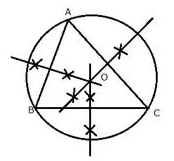
- Draw a line segment BC = 6 cm
- With centers B and C, draw two arcs of radius 6 cm which intersect each other at A.
- Join AC and AB.
- Draw perpendicular bisectors of Ac, AB and BC intersecting each other at O.
- With heart O, and radius OA or OB or OC draw a circle which volition pass through A, B and C.
This is the required circumcircle of triangle ABC.
Question 14.
Construct a circle, inscribing an equilateral triangle with side 5.half dozen cm.
Solution:
Steps of Construction:
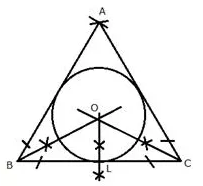
- Draw a line segment BC = five.6 cm
- With centers B and C, depict two arcs of 5.half-dozen cm radius each which intersect each other at A.
- Join AB and Ac.
- Depict bending bisectors of ∠B and ∠Cintersecting each other at O.
- From O, draw OL ⊥ BC.
- At present with centre O and radius OL, draw a circumvolve which will impact the sides of ∆ABC
This is the required circle.
Question 15.
Depict a circumvolve circumscribing a regular hexagon of side 5 cm.
Solution:
Steps of Construction:
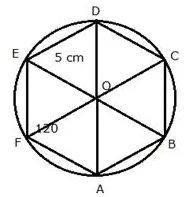
- Draw a regular hexagon ABCDEF with each side equal to 5 cm and each interior angle 120º.
- Join its diagonals Advertizement, Be and CF intersecting each other at O.
- With centre as O and radius OA, draw a circle which volition pass through the vertices A, B, C, D, E and F.
This is the required circumcircle.
Question sixteen.
Describe an inscribing circle of a regular hexagon of side v.8 cm.
Solution:
Steps of Construction:
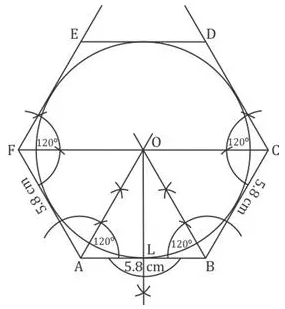
- Draw a line segment AB = 5.eight cm
- At A and B, draw rays making an bending of 120° each and cut off AF = BC = 5.viii cm
- Again F and C, draw rays making an angle of 120° each and cut off Fe = CD = 5.8 cm.
- Join DE. And then ABCDEF is the regular hexagon.
- Draw the bisectors of ∠A and ∠B intersecting each other at O.
- From O, draw OL ⊥ AB
- With centre O and radius OL, draw a circle which touches the sides of the hexagon.
This is the required in circle of the hexagon.
Question 17.
Construct a regular hexagon of side 4 cm. Construct a circle circumscribing the hexagon.
Solution:
Steps of Construction:
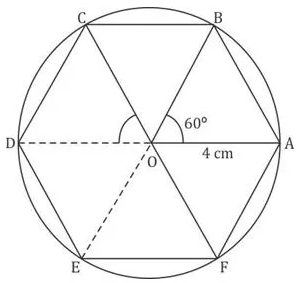
- Draw a circle of radius 4 cm with centre O
- Since the interior bending of regular hexagon is 60o, draw radii OA and OB such that ∠AOB = 60°
- Cut off arcs BC, CD, EF and each equal to arc AB on given circle
- Bring together AB, BC, CD, DE, EF, FA to get required regular hexagon ABCDEF in a given circle.
The circle is the required circum circle, circumscribing the hexagon.
Question 18.
Draw a circle of radius iii.5 cm. Mark a point P outside the circumvolve at a altitude of vi cm from the centre. Construct two tangents from P to the given circumvolve. Measure and write downwardly the length of one tangent.
Solution:
Steps of Structure:
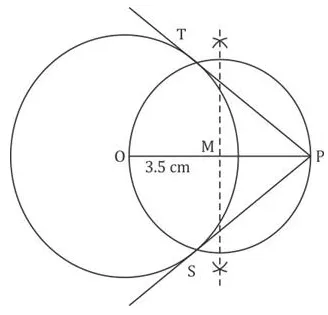
- Draw a line segment OP = half-dozen cm
- With center O and radius 3.5 cm, describe a circle
- Depict the midpoint of OP
- With centre M and diameter OP, draw a circumvolve which intersect the circle at T and S
- Bring together PT and PS.
PT and PS are the required tangents. On measuring the length of PT = PS = iv.8 cm
Question 19.
Construct a triangle ABC in which base BC = 5.5 cm, AB = six cm and chiliad∠ABC =120˚.
i. Construct a circle circumscribing the triangle ABC.
ii. Draw a cyclic quadrilateral ABCD then that D is equidistant from B and C.
Solution:
Steps of Construction:
i.
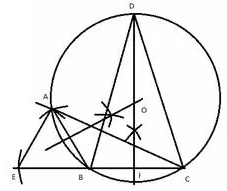
a. Draw a line BC = 5.iv cm.
b. Draw AB = vi cm, such that chiliad ∠ABC = 120°.
c. Construct the perpendicular bisectors of AB and BC, such that they intersect at O.
d. Draw a circumvolve with O as the radius.
ii.
(east) Extend the perpendicular bisector of BC, such that
it intersects the circle at D.
(f) Bring together BD and CD.
(1000) Here BD = DC.
Question 20.
Using a ruler and compasses but :
(i) Construct a triangle ABC with the following data: AB = 3.5 cm, BC = 6 cm and ∠ABC = 120°.
(ii) In the aforementioned diagram, depict a circle with BC as diameter. Notice a betoken P on the circumference of the circle which is equidistant from AB and BC.
(iii) Measure ∠BCP.
Solution:
Steps of constructions:
1. Draw a line segment BC = half dozen cm.
At B, describe a ray BX making an angle of 120° with BC.
With B as centre and radius three.five cm, cutting-off AB = iii.5 cm.
Bring together Ac
Thus, ABC is the required triangle.
ii. Draw perpendicular bisector MN of BC which cuts BC at point o.
With O every bit center and radius = OB, draw a circle.
Draw angle bisector of ∠ABC which meets the cirde at bespeak P.
Thus, point P is equidistant from AB and BC
three. On measuring, ∠BCP = thirty°
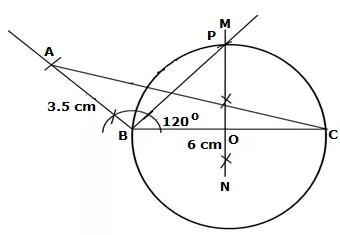
Question 21.
Construct a ∆ABC with BC = half dozen.5 cm, AB = 5.5 cm, AC = 5 cm. Construct the incircle of the triangle. Mensurate and record the radius of the incircle.
Solution:
Steps of construction:
- Draw BC = half-dozen.5 cm.
- With B as heart, draw an arc of radius v.5 cm.
- With C as oentre, draw an arc of radius 5 cm.
Allow this arc meets the previous arc at A. - Join AB and AC to get ∆ABC.
- Draw the bi sectors of ∠ABC and ∠ACB.
Let these bisectors see each other at O. - Describe ON ⊥ BC.
- With O as middle and radius ON, draw a inarcle that touches all the sides of ∆ABC
- By measurement, radius ON = 1.5 cm
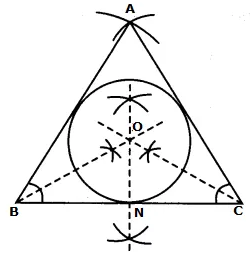
Question 22.
Construct a triangle ABC with AB = five.5 cm, AC = 6 cm and ∠BAC = 105°. Hence :
(i) Construct the locus of points equidistant from BA and BC.
(ii) Construct the locus of points equidistant from B and C.
(three) Mark the point which satisfies the above two loci as P. Measure and write the length of PC.
Solution:
Steps of structure:
- Draw AB = five.five cm
- Construct ∠BAR = 1050
- With middle A and radius 6 cm, aut off arc on AR at C.
- Join BC. ABC is the required triangle.
- Draw angle bisector BD of ∠ABC, which is the loss of points equidistant from BA and BC.
- Draw perpendicular bisector EF of BC, which is the locus of points equidistant from B and C.
- BD and EF intersect each other at point P.
Thus, P satisfies the in a higher place two lod.
Past measurement, PC = iv.eight cm
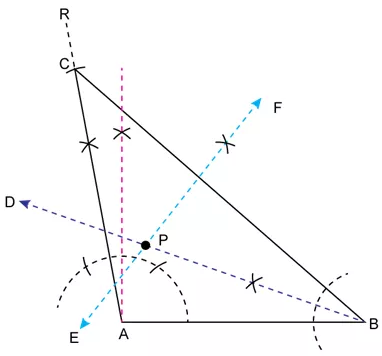
Question 23.
Construct a regular hexagon of side 5 cm. Hence construct all its lines of symmetry and proper name them. (2016)
Solution:
Steps of construction:
- Draw AF measuring five cm using a ruler.
- With A as the centre and radius equal to AF, depict an arc higher up AF.
- With F every bit the centre, and same radius cut the previous arc at Z
- With Z as the centre, and same radius draw a circumvolve passing through A and F.
- With A as the centre and same radius, draw an arc to cut the circle in a higher place AF at B.
- With B as the eye and aforementioned radius, draw an arc to cut the circle at C.
- Echo this procedure to go remaining vertices of the hexagon at D and E.
- Join consecutive arcs on the circle to course the hexagon.
- Draw the perpendicular bisectors of AF, Fe and DE.
- Extend the bisectors of AF, FE and DE to come across CD, BC and AB at X, L and O respectively.
- Bring together AD, CF and EB.
These are the 6 lines of symmetry of the regular hexagon.
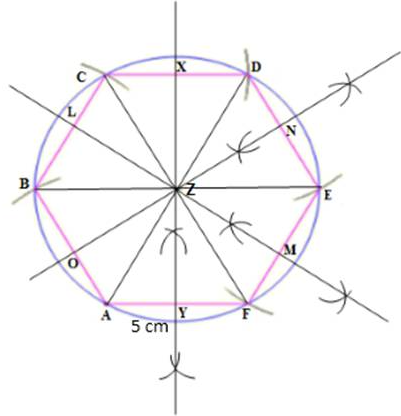
Question 24.
Draw a line AB = 5 cm. Mark a point C on AB such that AC = three cm. Using a ruler and a compass only, construct:
(i) A circle of radius 2.5 cm, passing through A and C.
(ii) Construct 2 tangents to the circle from the external indicate B. Measure out and record the length of the tangents. (2016)
Solution:
Steps for structure:
- Draw AB = five cm using a ruler.
- With A as the centre cut an arc of three cm on AB to obtain C.
- With A equally the center and radius 2.5 cm, draw an arc to a higher place AB.
- With same radius, and C as the centre describe an arc to cutting the previous arc and mark the intersection equally O.
- With O as the centre and radius ii.v cm, describe a circumvolve so that points A and C lie on the circle formed.
- Join OB.
- Draw the perpendicular bisector of OB to obtain the mid-point of OB, M.
- With the M as the eye and radius equal to OM, draw a circle to cutting the previous circle at points P and Q.
- Bring together Lead and QB. PB and QB are the required tangents to the given circle from outside point B.
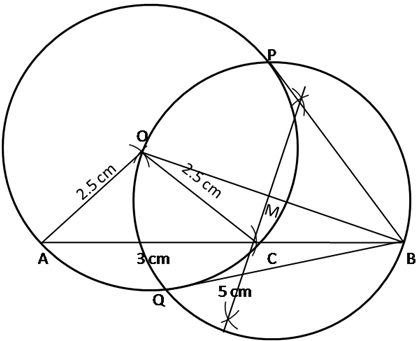
QB = Lead = 3 cm
That is, length of each tangent is iii cm.
Solution 25.
Steps of structure :
- Draw a line AB = 7 cm
- Taking P as middle and same radius, draw an arc of a circumvolve which intersects AB at Yard.
- Taking One thousand every bit eye and with the aforementioned radius as before drawn an arc intersecting previously drawn arc, at signal North.
- Describe the ray AX passing through N, and so ∠XAB = threescore°
- Taking A every bit middle and radius equal to 5 cm, draw an arc cut AX at C.
- Join BC
- The required triangle ABC is obtained.
- Describe angle bisector of ∠CAB and ∠ABC
- Mark their intersection as O
- With O as middle, draw a circle with radius OD
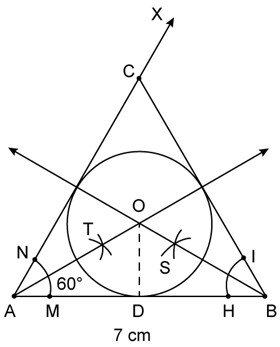
Solution 26.
Steps for construction :
- Draw BC = 6.8 cm.
- Mark point D where BD = DC = 3.iv cm which is mid-point of BC.
- Mark a indicate A which is intersection of arcs Advertising = four.4 cm and AB = 5 cm from a signal D and B respectively.
- Join AB, Advertizement and AC. ABC is the required triangle.
- Draw bisectors of bending B and angle C which are ray BX and CY where I is the incentre of a circumvolve.
- Draw incircle of a triangle ABC.
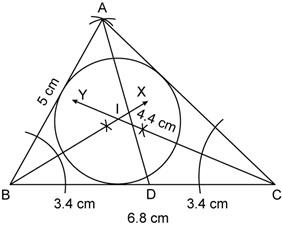
Solution 27.
Steps for construction :
- Describe concentric circles of radius 4 cm and half dozen cm with centre of O.
- Accept point P on the outer circumvolve.
- Join OP.
- Draw perpendicular bisectors of OP where 1000 is the midpoint of OP.
- Take a distance of a point O from the signal M and mark arcs from Thousand on the inner circumvolve it cuts at point A and B respectively.
- Join PA and PB.
We observe that PA and PB are tangents from outer circle to inner circle are equal of a length 4.5 cm each.
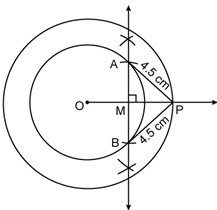
Solution 28.
Steps for construction :
- Draw BC = 7.two cm.
- Depict an angle ABC = 90°using compass.
- Depict BD perpendicular to AC using compass.
- Join BD.
- Depict perpendicular bisectors of AB and BC which intersect at I, where I is the circumcentre of a circumvolve.
- Draw circumcircle using circumcentre I. we get radius of a circle is 4.7 cm.
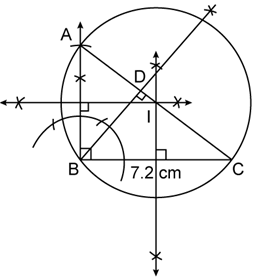
More Resources for Selina Concise Form ten ICSE Solutions
- Selina Maths Class ten ICSE Solutions
- Selina ICSE Physics Class 10 Solutions
- Concise Chemistry Course 10 ICSE Guide Pdf
- Selina ICSE Class 10 Biology Solutions
ICSE Solutions Selina ICSE Solutions
Source: https://www.aplustopper.com/selina-icse-solutions-class-10-maths-constructions-circles/
0 Response to "Draw a Circle With Centre O and Radius 2.5cm"
ارسال یک نظر